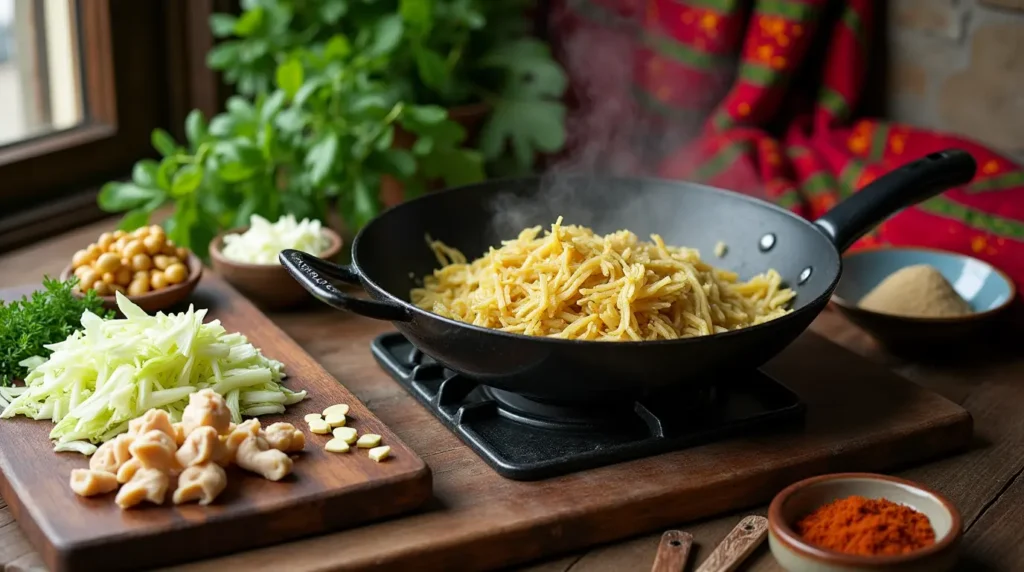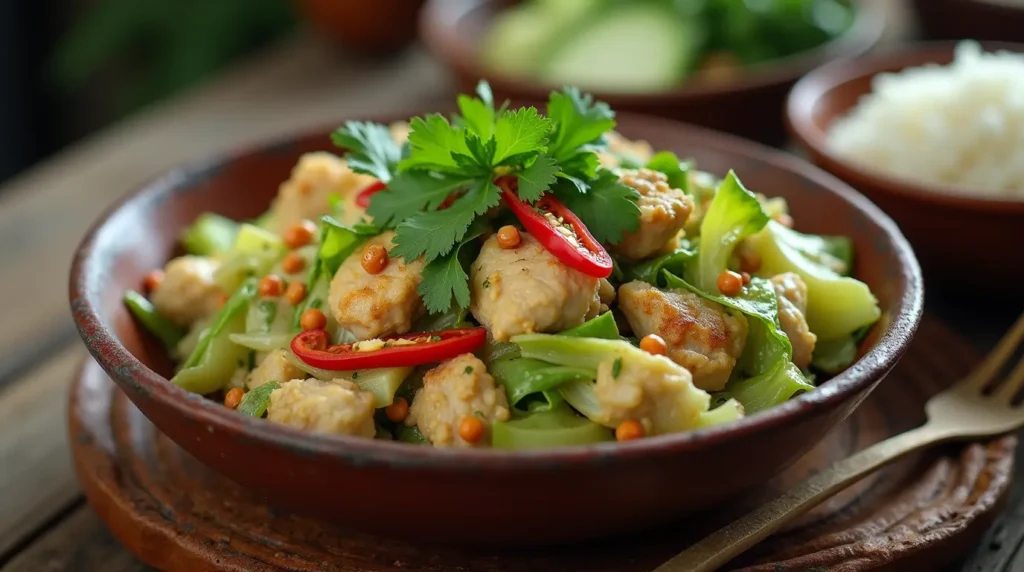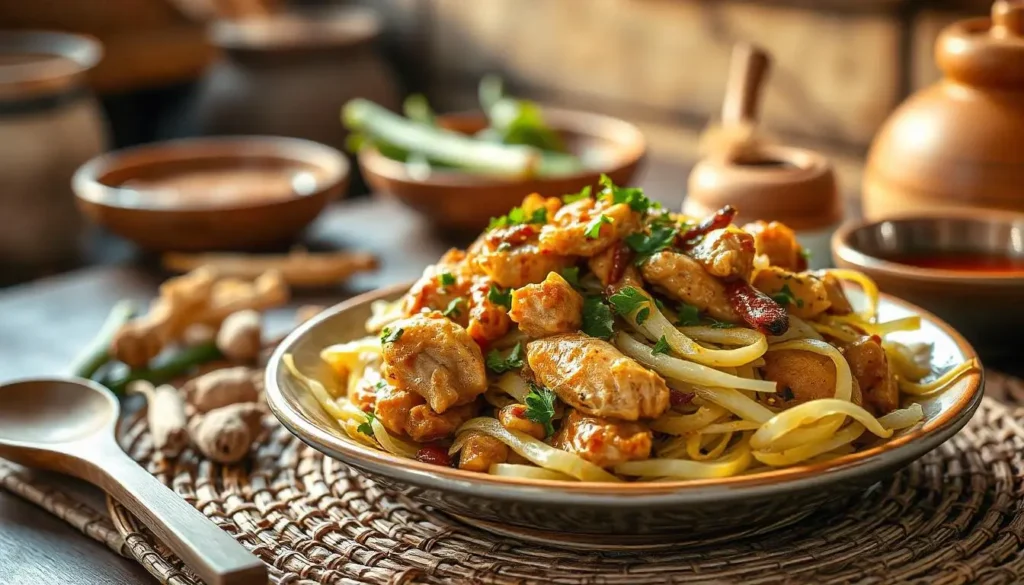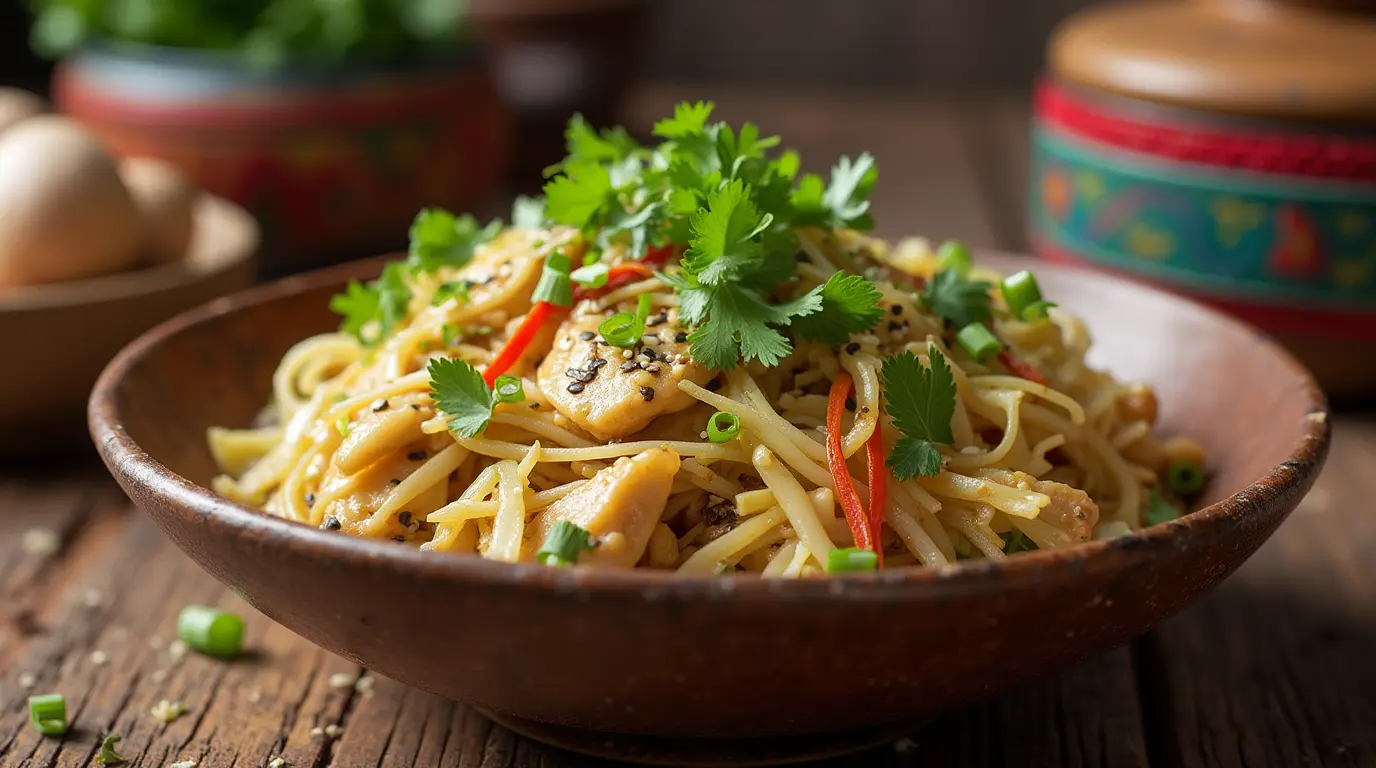Introduction
Hmong culture traditions and cuisine are a remarkable reflection of heritage, resilience, and community. Rooted in centuries-old practices, the Hmong people have preserved their unique way of life through vibrant ceremonies, symbolic rituals, and distinctive culinary delights. Hmong cuisine, with its flavorful dishes like Hmong sausage and herbal soups, showcases an artful blend of taste, history, and tradition. Traditional customs, such as those involving the symbolic role of chickens, further highlight the deep spiritual connections within Hmong culture traditions. This enduring fusion of heritage and gastronomy offers a compelling insight into the heart of Hmong culture and cuisine.
Table of Contents
Ingredients Needed for the Dish
Essential Ingredients for Hmong Cabbage and Chicken
To make the flavorful Hmong cabbage and chicken recipe, you’ll need the following staples of Hmong cuisine, which reflect the heart of Hmong culture traditions and cuisine:
- 1 pound of chicken (thighs or breast, thinly sliced).
- 4 cups of green cabbage, shredded.
- 2 cloves of garlic, minced.
- 1 small onion, thinly sliced.
- 2 tablespoons of cooking oil (vegetable or peanut oil).
- 2 tablespoons of soy sauce.
- 1 tablespoon of fish sauce.
- Salt and pepper, to taste.
Spicing Up the Dish with Traditional Hmong Flavors
For an authentic taste of Hmong cuisine, don’t forget these traditional Hmong spices and herbs:
- A handful of fresh cilantro for garnish.
- 1 teaspoon of lemongrass (optional).
- 1 red chili, finely chopped (for a little heat).
These ingredients not only enhance the dish but also reflect the bold and vibrant flavors that define Hmong culture traditions and cuisine.
Stay tuned for Part 2, where we’ll explore how to prepare this delightful Hmong cabbage and chicken recipe step by step!elightful dish step by step! Let’s get cooking!
How to Prepare Hmong Cabbage and Chicken

Step 1: Prep Your Ingredients According to Hmong Culinary Traditions
First, gather all your ingredients and have them ready to go. Begin by slicing the chicken into thin, bite-sized strips for even cooking. Then, shred the green cabbage and mince the garlic. Don’t forget to slice the onion and chop the red chili for that hint of heat. With everything prepped, you’re already halfway to mastering this flavorful Hmong cabbage and chicken recipe, a dish that reflects the heart of Hmong culture traditions and cuisine.
Step 2: Cooking with Bold Flavors from Hmong Cuisine
Heat two tablespoons of cooking oil in a pan over medium heat. Start by sautéing the garlic and onion until they become fragrant and slightly golden. This step is essential in creating the bold, aromatic flavors that define Hmong cuisine. Next, add the chicken, cooking until it’s tender and no longer pink. Toss in the cabbage, stirring often to allow it to gently soften. Sprinkle in the soy sauce, fish sauce, and a pinch of salt and pepper to taste. Stir everything together until the flavors meld harmoniously. For a bolder taste, incorporate the chili and lemongrass, which are staples in Hmong culinary traditions.
Serving and Enjoying Your Hmong Dish
Garnish and Serve: Presentation Tips for Hmong Cuisine
Now that your Hmong cabbage and chicken recipe is ready, it’s time to plate up! Transfer the delicious mixture onto a serving dish, ensuring the cabbage and chicken are evenly distributed. Garnish generously with fresh cilantro for that perfect finishing touch. This simple yet vibrant presentation not only enhances the dish but also reflects the beauty and authenticity of Hmong culture traditions and cuisine.
Pair It Perfectly with Other Hmong Dishes
This dish pairs wonderfully with steamed jasmine rice or vermicelli noodles, staples of Hmong cuisine, making it a complete and satisfying meal. Whether you’re serving it for a family dinner or a special gathering, this flavorful recipe is sure to delight. By enjoying this dish, you’re experiencing the rich culinary heritage of Hmong culture traditions and cuisine, where bold flavors and fresh ingredients come together to create something truly special.
Helpful Tips for Cooking Hmong Cabbage and Chicken

Achieving the Perfect Texture in Hmong Dishes
For the best results, it’s important to cook the cabbage to the right texture. In Hmong cuisine, the balance of textures is key to creating a satisfying dish. While you don’t want the cabbage to be too soft, a slight crunch can add a delightful contrast to the tender chicken. Stirring often and lowering the heat once the cabbage starts wilting can help maintain this balance. Additionally, slicing the cabbage evenly ensures it cooks uniformly, giving a consistent bite that reflects the care and precision of Hmong culture traditions and cuisine.
Balancing Flavors to Reflect Hmong Culture Traditions and Cuisine
The key to a flavorful Hmong cabbage and chicken recipe lies in balancing the bold and subtle flavors that define Hmong cuisine. If you prefer a milder taste, reduce the fish sauce slightly, or if you enjoy a spicy kick, don’t hesitate to add more chili. Be sure to taste the dish as you go, adjusting seasonings little by little to achieve the perfect, harmonious flavor. This attention to balance is a hallmark of Hmong culture traditions and cuisine, where every ingredient plays a meaningful role.
Keep Exploring Hmong Culture Traditions and Cuisine
Expanding Your Culinary Repertoire with Hmong Dishes and Traditions
Cooking is an adventure, and trying out new recipes is a wonderful way to connect with different cultures. Once you’ve mastered this Hmong cabbage and chicken recipe, consider exploring other dishes that celebrate the vibrant flavors and fresh ingredients of Hmong cuisine.
For more delicious recipes, check out our article on creating traditional dishes with a modern twist. You’ll find inspiration to bring the rich culinary heritage of Hmong culture traditions and cuisine into your kitchen!
For more delicious Hmong-inspired recipes, check out our Chicken with Peanut Butter Recipe.
Tips for Perfecting Your Hmong Cabbage and Chicken Dish in Hmong Culture

Mastering Basic Cooking Techniques in Hmong Cuisine
Perfecting your Hmong cabbage and chicken recipe doesn’t have to be complicated! Start by focusing on fresh, high-quality ingredients, a cornerstone of Hmong culture traditions and cuisine. Fresh cabbage provides a crisp texture, while tender chicken enhances the dish’s flavor. Additionally, slicing your ingredients uniformly ensures they cook evenly and blend seamlessly. Taking the time to prepare your ingredients properly is the first step toward success and reflects the care and precision of Hmong culinary traditions.
Adding Your Personal Twist to Traditional Hmong Recipes
Once you’ve mastered the basics, don’t hesitate to experiment! For instance, you could add fresh herbs like cilantro or basil for an aromatic twist. Alternatively, try using a squeeze of lime to brighten up the dish with a zesty tang. These small adjustments can elevate your Hmong cabbage and chicken recipe while making it uniquely yours. Experimenting with flavors is a great way to honor Hmong culture traditions and cuisine while adding your personal touch.
Serving and Enjoying Hmong Dishes with Family
Presentation Tips for Hmong Dishes: A Cultural Approach
When it comes to serving, a beautiful presentation can elevate the entire experience. Arrange your Hmong cabbage and chicken recipe on a large, vibrant platter to showcase its fresh ingredients. Add a few sprigs of herbs for garnish, and you’ll have a dish that’s as visually appealing as it is delicious. This attention to detail reflects the beauty and care found in Hmong culture traditions and cuisine.
Sharing Your Hmong Dish with Loved Ones and Celebrating Tradition
The best meals are shared, so invite family or friends to enjoy this flavorful creation with you. Pair the dish with steamed jasmine rice or a side of fresh, crunchy cucumbers to complete the meal. With its perfectly balanced flavors, the Hmong cabbage and chicken recipe is bound to be a crowd-pleaser. Sharing food is a meaningful way to celebrate Hmong culture traditions, where meals bring people together in harmony and joy.
Customizing Your Recipe to Reflect Hmong Culture Traditions and Cuisine
Adjusting Flavors to Your Taste
One of the best things about the Hmong cabbage and chicken recipe is how easy it is to adjust to your taste. If you enjoy a bit of heat, try adding chili flakes or a dash of hot sauce. For a sweeter flavor, drizzle in some honey or coconut milk for a creamy touch. These small changes allow you to balance the flavors while staying true to the essence of Hmong cuisine.
Exploring Ingredient Variations
You can also customize the recipe by changing or adding ingredients. Try adding mushrooms or bell peppers for extra texture and color. If you prefer, replace the chicken with tofu or shrimp for a different protein option. For added crunch, top the dish with toasted sesame seeds or crushed peanuts. These variations allow you to create a version of the Hmong cabbage and chicken recipe that’s uniquely yours while still honoring the rich flavors of Hmong culture traditions and cuisine.
FAQs
What is the Hmong tradition of chicken?
Chicken is important in Hmong culture. It often symbolizes respect, unity, and gratitude. Chickens are used in ceremonies like New Year celebrations and spiritual rituals. During these events, chickens may be slaughtered and offered to ancestors or spirits. This practice shows the strong link between food and spirituality in Hmong traditions.
What is the Hmong signature dish?
Hmong cuisine is diverse, but one of the signature dishes is “Khaub Piaj” (rice soup). This dish has a flavorful broth with herbs, garlic, and other spices. It is often served with chicken, pork, or fish. Another popular dish is Hmong sausage, which is packed with bold flavors.
What is a taboo in Hmong culture?
Hmong culture has several taboos. One is showing disrespect to elders or spiritual practices. Disrupting sacred ceremonies or mocking ancestral rituals is considered wrong. Certain foods and objects may also be avoided during specific rituals to maintain spiritual harmony.
What is the history of the Hmong chicken?
The use of chicken in Hmong culture goes back centuries. Chickens were important for food and also had spiritual meaning. They symbolized prosperity and protection. Over time, chicken became central to many rituals and dishes, representing Hmong resilience and respect for tradition.
Revised Conclusion:
Hmong culture traditions and cuisine are a testament to the rich heritage, delicious food, and deep spiritual ties of the Hmong people. From signature dishes like Hmong sausage to the symbolic role of chicken in rituals, these elements beautifully highlight the strength and resilience of Hmong culture.
Exploring Hmong Culture in Depth:
The adaptability and creativity of the Hmong people are evident in their vibrant traditions and culinary practices. A key part of Hmong culture traditions and cuisine is the way food brings families and communities together. Dishes like Hmong sausage and chicken soup showcase bold flavors, fresh ingredients, and the resourcefulness of Hmong cooking. The symbolic role of chicken in rituals and ceremonies further reflects the deep spiritual connections within Hmong traditions.
By preserving these practices, Hmong culture traditions and cuisine continue to thrive, offering the world valuable insight into a heritage that values balance, harmony, and resilience. Through their art, food, and spiritual practices, the Hmong share their unique identity on a global stage. Learning about Hmong culture traditions and cuisine not only deepens our understanding of their way of life but also fosters a greater appreciation for diversity and human connection.

